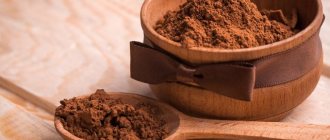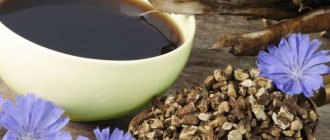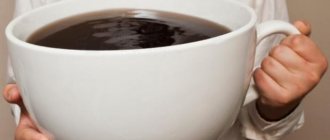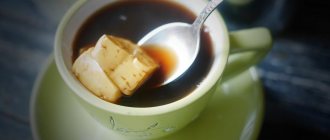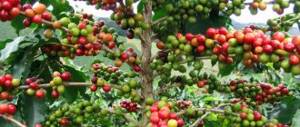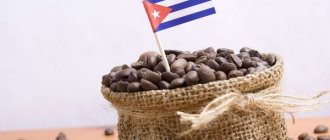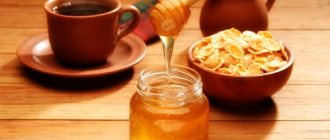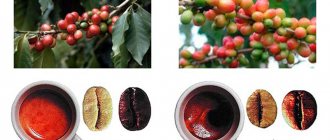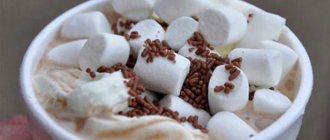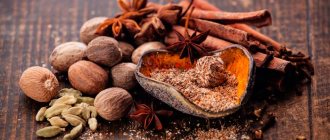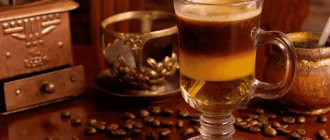Why children should not drink natural coffee
The main component of coffee, caffeine, is a powerful stimulant. When consuming an extracted coffee drink from natural beans, it enters the body in significant quantities.
From coffee, a baby can become nervous, whiny, and easily excited by any minor event. The systematic intake of caffeine into a fragile body develops persistent sleep disturbances. Nervous excitement is extremely dangerous due to excessive consumption of energy, and therefore nutrients. Thus, coffee consumption at an early age leads to delayed physical development and disturbances in the normal mental state, including:
- Violation of salt metabolism. As a strong diuretic, caffeine promotes frequent urination, which in turn flushes a large amount of beneficial substances from the body.
- Heart rhythm failure. Caffeine can cause arrhythmia. This condition causes chest discomfort or pain.
- Increased secretion of gastric juice and the development of early gastritis.
What can replace coffee for children?
Against the background of such a picture, the answer to the question “what do they give children in kindergarten?” becomes obvious. Children receive a surrogate, or coffee substitute. The drink contains natural ingredients of plant origin - barley, chicory, acorns, soy. All ingredients go well together and taste great individually. In most cases, the products are fried and finely chopped before consumption.
In the store you can find ready-made powder surrogates. Their recipes were developed in distant socialist times and still remain unchanged. All components are absolutely safe, because completely natural. You can purchase the extract in retail chains (less often in a supermarket). The following names will appear on the packaging:
- "Morning". Barley-rye mixture with a small part of chicory;
- "Evening". Exclusively roasted barley grain;
- "Fragrance." Drink made from roasted barley and chicory;
- “Golden Ear”, “Summer”. Chicory and barley in equal parts.
It is better for children to replace coffee with chicory
Why is coffee contraindicated for children?
Natural coffee contains a stimulating substance - caffeine. It has a stimulating effect on the central nervous system. When drinking a drink made from coffee beans, this alkaloid enters the body in considerable doses.
Caffeine can cause tearfulness, nervousness, and insomnia in a child. It is harmful not only to the children’s nervous system, but also to the entire body for the following reasons:
- Coffee acts as a diuretic and removes fluid from the body. As a result, the child's body loses nutrients that are necessary for growth and development.
- Caffeine stimulates the cardiovascular system. The child may develop tachycardia and chest discomfort.
- Coffee stimulates the secretion of gastric juice. This can lead to abdominal pain and the development of early gastritis.
Therefore, natural coffee is never included in coffee drinks given in kindergarten.
Children's coffee drink - the word coffee is only in the name
Preparing a children's coffee drink using this powder is completely safe due to the absence of caffeine. In addition, all plant components from the barley-chicory drink are rich in vitamins and minerals. For example, vitamin C, group B, iron, calcium. A large amount of coarse fiber in the extract perfectly normalizes the intestinal microflora.
Some of the newest industrial formulations may contain coffee bean extract, coffee flavoring, and more. As a rule, they serve as flavor enhancers and their percentage is no more than 1-2%.
Important! You need to carefully read the ingredients on the package if the availability of coffee is of fundamental importance to the buyer.
Children's coffee prepared in kindergarten contains milk and sugar in addition to the surrogate. That is why it is worth considering that only the name remains of the coffee in the nursery coffee drink.
The benefits of coffee drinks
Coffee baby drinks are free of harmful caffeine, but rich in vitamins and minerals. In addition, they contain fiber, which improves digestion.
Sometimes these drinks contain coffee flavoring. This substance is harmless, it is added to enhance the taste.
Kindergarten drinks usually consist of substitute coffee, milk and sugar. From coffee there is only one name left in them.
Next, I will share a classic recipe for a coffee drink that is served to children in kindergarten.
Coffee drink recipes
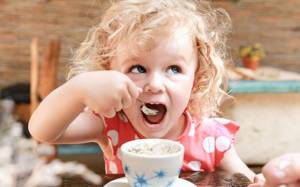
It is still used to this day in preschool institutions, according to the established menu card. Exact dosage of products per serving:
- Pasteurized milk 50 grams;
- Purified water 60 grams;
- Surrogate coffee powder - 5 grams;
- Granulated sugar 5 grams.
To prepare a children's coffee drink, add a dose of substitute powder to boiling water and boil for 3-5 minutes. Then strain, combine with milk and sugar, and boil again for no more than 2-3 minutes.
Composition of coffee drink
The composition of surrogate coffee includes the following components:
- chicory
- barley
- acorn
- soybeans
- rose hip
- chestnut.
To prepare delicacies associated with kindergarten, according to the technological maps of the preschool educational institution, you will need:
- coffee powder - 8 g;
- UHT milk - 100 ml;
- water - 100 ml;
- sugar - 12 g.
Preparation: bring water to a boil, add coffee powder. Then the boiled mixture is infused for 5 minutes, after which sugar and milk are added and brought to a boil again.
Barley coffee recipe
Preparing a coffee drink based on a purchased extract is optional. There is a simple and affordable recipe that is easy to implement at home.
For the drink you need to take 3 tbsp. spoons of barley grain. It is recommended to take the largest, undamaged grains without chips or mold stains. They must be thoroughly rinsed under running water and dried. The grain is then roasted in a very hot pan for 5-7 minutes or until the grain has darkened sufficiently. After cooling, the barley is ground in a coffee grinder and a “coffee” drink is prepared in the traditional way. To do this, the resulting powder is brewed with 200-250 grams of boiling water and simmered for 3-5 minutes. To improve the taste, honey, sugar, and cinnamon are added.
If the taste of pure grain seems unpleasant to your child, you can experiment with additional ingredients. These may include dried rose hips, roasted soybeans or acorns.
Acorns should be collected in late autumn, when they are fully ripe. The fruits are washed, dried and cleared of rough skin. After this, the kernel is crushed and lightly fried. Acorn coffee is an excellent preventative against scrofula or rickets.
Attention! Dried rose hips have a strong diuretic effect, so its use is contraindicated in large quantities.
Chicory root can be successfully replaced with Jerusalem artichoke tubers collected in early spring or late autumn. During this period they contain the greatest amount of useful substances.
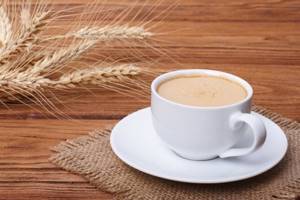
Classic recipe
Prepare the following ingredients:
- pasteurized milk or cream - a quarter cup;
- purified drinking water - a quarter glass;
- granulated sugar and surrogate coffee drink (of your choice) - a teaspoon each.
Boil the water. Throw powdered coffee surrogate into it. Boil the drink for about 3 - 5 minutes.
Then strain the liquid. Add granulated sugar and milk (cream) to the drink. Boil again for no more than 3 minutes.
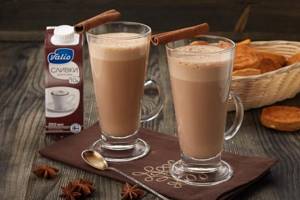
Coffee drink in kindergarten recipe
“Mom, today in kindergarten we were treated to a coffee drink, it’s so delicious” - the words of a contented lisping toddler instantly transport you to childhood. At that time, it smelled deliciously of “cock on a stick”, sugar toffee, condensed milk, and yes - coffee . We may have trouble remembering many things and events, but the smells are good - they are not so easy to erase from memory. We drank a coffee drink, imagining that it was real coffee, and we were those same business adults. We dreamed of growing up quickly, naive. But this was a lyrical digression, the author’s trick to further “immerse” the reader in the topic under consideration. Let's take a closer look at what a coffee drink is and what it is eaten with? What is its composition and does it harm our children? Let's find out!
Don't be alarmed; coffee in children's coffee drinks is only in the name. There is no natural coffee in most formulations; it is usually replaced with the following components:
As can be seen from the list, the composition is very harmless.
Giving a coffee drink to children over two years of age is allowed, the daily norm is no more than 1 cup per day. If the child is not allergic to its constituent components, “surrogate” coffee (it is also called that) will not only not harm the child, but will also saturate the child’s body with the necessary vitamins and microelements. For example, chicory is able to balance the unstable nervous system of children, rose hips have a general strengthening effect. A coffee drink can normalize the intestinal microflora, remove toxic substances (due to oligosaccharides and pectins in its composition), and improve appetite, which is especially important for those with little appetites. The oats included in the composition contain a large amount of protein, which is simply necessary for a rapidly growing child's body, barley contains B vitamins and magnesium.
Sometimes natural coffee is included in the drink. Parents should not worry about this: firstly, the amount is usually insignificant, and secondly, caffeine has an invigorating and tonic effect on the body. If consumed in moderation, it will not cause any harm to the baby’s body. But you should know that an overdose of a drink that contains natural coffee can lead to leaching of calcium from the body (this is a property of caffeine) and provoke increased excitability. Please note that you should avoid drinking this drink in the evening.
Let's consider the nutritional indicators given in the technological map of the drink. So, KBJU of surrogate coffee per 100 grams:
- Proteins 1.56 g;
- Fat 1.33 g;
- Carbohydrates 7.1 g;
- Calorie content 46.7 kcal.
- The card also shows vitamins (B1, B2, C) and microelements (calcium, iron).
Coffee drink for children
A revelation for coffee lovers will be the fact that the coffee drink that children receive in kindergarten has nothing to do with the generally accepted varieties of coffee (glazed, Americano, espresso, latte, etc.) and even less so with caffeine.
The harm of a coffee drink lies in the sugar content, because a child will refuse to drink unsweetened drinks. Sugar is a high-calorie product that harms children’s bodies: it disrupts the absorption of calcium and iron, causes hyperactivity and sleep disturbances, and causes dental caries. In addition, sugar is addictive, which can lead to weight problems in the future.
Methods for preparing a coffee drink
You can buy a coffee drink in a regular store in the grocery department. The most popular are the following industrial brands: “Morning” (barley-rye with the addition of chicory); “Evening” (barley-based drink); “Summer”, “Golden Ear” (barley-rye drink); “Aroma”, “Kurzene” (barley-chicory drink).
It’s easy to prepare, below is a classic recipe borrowed from the Internet (the dosage is calculated for one serving of the drink):
- Coffee drink 4-5 grams;
- Pasteurized milk 50 grams;
- Drinking water 50-60 grams;
- Granulated sugar 5 grams
- Place the drink in boiling water and bring to a boil. Then it must be infused (5 minutes is enough), strained, added hot milk, sugar and boiled.
What is a substitute for coffee?
Coffee drinks for children use surrogates that taste similar to coffee. Most often, such products are made based on the following components:
“I felt hunted: Kate Winslet on life after Titanic”
Vans has launched a competition for artists. The prize will be 50 thousand dollars
Case 5 minutes: a man opened a frozen car door with a hammer
- barley;
- chicory;
- soy;
- acorns
These ingredients are thoroughly crushed and fried. They taste good and are absolutely safe for children's health.
On store shelves you can find ready-made coffee drinks made from barley and chicory. The most popular brands are “Morning”, “Evening”, “Golden Ear”, “Aroma”, “Summer”. They contain exclusively natural ingredients.
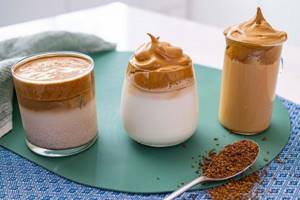
Barley coffee recipe.
You need to take 3 teaspoons of barley grains (the larger the grains, the better). They should be rinsed well and dried completely. Then fry the barley in a very hot frying pan until they darken and a characteristic smell appears. Grind the finished grains in a coffee grinder, pour into a container with water (150-200 ml), bring to a boil and leave for 3-5 minutes. To improve the taste, you can add a spoonful of honey, a pinch of cinnamon or lemon to the drink.
The recipe for surrogate coffee made from acorns is worthy of special attention. The benefit of such a drink for the child’s body lies, first of all, in the prevention of rickets and scrofula. Ripe fruits selected in the fall are washed, dried, and shelled. Then the acorns, cut into small pieces, are dried in the oven for at least half an hour, crushed in a coffee grinder or blender and prepared like barley, in the manner discussed above.
Internet sources offer a very interesting alternative version of a coffee drink made from the fruits of Jerusalem artichoke (earthen pear). Tubers collected in autumn or spring must be cleaned, cut into small pieces, and pour boiling water over them for a couple of minutes. Then dry and fry in the oven or in a frying pan. Next, according to the principle described above, the Jerusalem artichoke is crushed and brewed. This drink will be useful for all children, but it is especially recommended for people with diabetes. The finished drink needs to be poured into cups and the little ones will be happy! Bon appetit!
How to make drinks according to kindergarten recipes
Ingredients:
- Rosehip – 25 g
- Water – 1 l
- Sugar – 15 g
Preparation:
So, the first card is a recipe for vitamin tea.
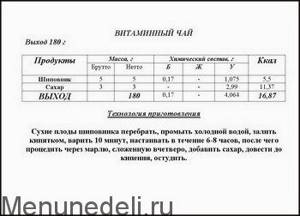
Sort out the dry rose hips, remove the dry stems and color.
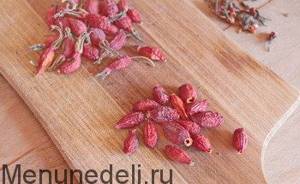
Rinse the prepared rose hips with cold water, add boiling water and cook for 10 minutes.
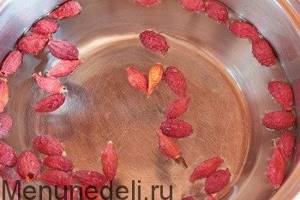
The next step is to fold the gauze into four layers and strain the rosehip infusion.
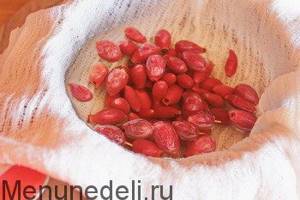
Add sugar to vitamin tea, bring to a boil and cool.
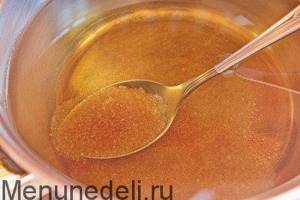
The technological card for preparing a coffee drink looks like this:
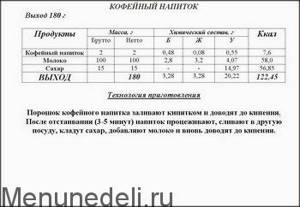
And this is the technology for preparing kindergarten cocoa with milk:
Multi-colored pictures and fancy patterns in a kaleidoscope!
A realistic horse will certainly delight your child.
Affordable, simple and fast! We make toys for children!
Don't be alarmed; coffee in children's coffee drinks is only in the name. There is no natural coffee in most formulations; it is usually replaced with the following components:
- Chicory;
- Rose hip;
- Barley;
- Acorns;
- Chestnuts;
- Soy.
As can be seen from the list, the composition is very harmless.
Sometimes natural coffee is included in the drink. Parents should not worry about this: firstly, the amount is usually insignificant, and secondly, caffeine has an invigorating and tonic effect on the body. If consumed in moderation, it will not cause any harm to the baby’s body. But you should know that an overdose of a drink that contains natural coffee can lead to leaching of calcium from the body (this is a property of caffeine) and provoke increased excitability. Please note that you should avoid drinking this drink in the evening.
Let's consider the nutritional indicators given in the technological map of the drink. So, KBJU of surrogate coffee per 100 grams:
- Proteins 1.56 g;
- Fat 1.33 g;
- Carbohydrates 7.1 g;
- Calorie content 46.7 kcal.
- The card also shows vitamins (B1, B2, C) and microelements (calcium, iron).
Hot and cold drinks in baby food
Hot drinks include tea, coffee, cocoa. Fruit and berry drinks (juices, fruit drinks, infusions), dairy drinks, milk, and fermented milk products are used cold.
Drinks are served for breakfast, lunch, dinner and afternoon tea, as they replenish the child’s body’s need for water and contain vitamins, minerals, flavors and other valuable substances. The tannin and essential oil contained in tea, which is also rich in vitamins B1, B2, C, P, PP, have a beneficial effect. Tea, coffee, and cocoa contain proteins and fat. But the alkaloids found in these products (caffeine in tea and coffee, theobromine in cocoa) have a stimulating effect on the nervous system. Therefore, in baby food, drinks made from weak tea and coffee, as well as coffee drinks, are used. Natural coffee and cocoa are not given to young children. These drinks are rarely included on menus for older children.
Hot drinks are served at a temperature of 70° C.
Tea with sugar (lemon, milk ). The porcelain teapot is rinsed with boiling water, dry tea (0.2 g per serving) is poured into it and hot boiled water is poured into it (filling no more than 1/3 of the teapot’s volume). The tea is infused for 5 minutes, covered with a lid and a napkin on top. At the same time, substances that give the infusion its vomit, taste, and aroma pass into the water. Then the kettle is filled with boiling water (^/4 of the total amount per serving). You cannot brew tea in a metal container, boil it, or leave it on the stove for a long time to infuse, as this destroys the valuable nutrients contained in the tea and deteriorates its taste. smell, color. When serving, put sugar in a cup or mug, pour in brewed tea, then pour boiling water. Sugar can be served separately in a socket or dissolved in boiling water (for mass distribution).
If tea is served with lemon (10 g per serving), then it is first scalded to remove bitterness, then cut into circles and placed on rosettes.
When dispensing milk tea, the milk is boiled and poured into the tea before serving. Milk or cream can also be served separately in a milk jug (50 g milk per serving). In addition, jam, marmalade, pastry or cake are often served with tea, placed in a rosette or on a dessert plate.
Tea 0.2, water 200, sugar 20. Yield 200.
Tea with milk and honey. Hot, strained tea is poured into a cup or glass (filling it to % of the volume), boiled milk and honey (20 g) are added, stirred and released.
Tea with syrup . Tea is poured into a mug or cup (150 g) and fruit syrup (50 g) is added.
Coffee with milk or coffee drink . Ground coffee is placed in a coffee pot, saucepan or stainless steel kettle, poured with boiling water, brought to a boil, moved to the edge of the stove, covered with a lid and left to infuse for 5-10 minutes. The finished coffee is filtered, combined with hot milk or a mixture of milk and water, sugar, and brought to a boil. Coffee is also prepared with condensed milk.
Coffee is served in a cup and saucer or mug; it is served with cookies, cakes, muffins, muffins, etc.
Natural coffee 2 or coffee drink 6, sugar 20, milk 100. Yield 200.
Cocoa . Cocoa powder is placed in a saucepan or kettle, combined with sugar, a little hot milk or water is added, and ground until smooth. Then the mass is diluted with continuous stirring with hot milk and water, and brought to a boil.
Dispense cocoa in a mug or cup. Just like coffee, you can serve it with cookies or cake.
Cranberry drink. The cranberries are sorted; washed with boiled water, kneaded and squeezed out the juice. The pulp is combined with water, boiled for 5-10 minutes, filtered, sugar is added, brought to a boil, then the heating is stopped and combined with the juice. The finished drink is cooled. Before serving, it is poured into cups or mugs. You can make a drink from any berries.
Apple drink. The washed apples are cut, seeds removed, cut into slices, placed in a bowl, poured with boiling water, sugar and finely chopped lemon zest are added and cooked for 15-20 minutes at low boil. The drink is cooled in a container, covered with a lid, then filtered. Store it in a cool place.
Orange or lemon drink. The zest removed from citrus fruits is peeled from the white subcutaneous skin, finely chopped, scalded, then poured with hot water, brought to a boil, sugar is added, left for 2-3 hours in a cold place and filtered. The juice is squeezed out of the fruit and combined with infused syrup.
Drink "Little Red Riding Hood". 100 g of blueberry juice is heated to a temperature of 70-80 ° C, poured into a bowl, 20 g of lemon and 30 g of raspberry syrup are added and released.
Prune infusion. The prunes are thoroughly washed, poured with boiled water, kept for 15-20 minutes, filtered, separated from the pits and cut into pieces. Then the prunes are combined with the separated infusion and sugar, poured with boiling water, left for 2-3 hours, poured into prepared dishes and released.
Juice from tomatoes. Ripe tomatoes are washed with boiled water, cut 1 and the juice is squeezed out of them using a juicer.
In winter, canned tomato juice is used.
Boiled milk . The milk is boiled and dispensed in an earthenware mug or glass. Serve it hot or chilled.
Honey milk. Combine 150 g of hot milk with 50 g of natural honey, stir, pour into mugs and release.
Milk with raspberry syrup . 150 g of hot milk is combined with 40 g of raspberry syrup, mixed, and released.
Milk drink . Milk (140 g per serving) is boiled, cooled, combined with milk ice cream (50 g), jam or fruit syrup (10-20 g) and released.
Kefir or curdled milk . Lactic acid products kefir, yogurt, fermented baked milk, acidophilus are dispensed in an earthenware mug or glass, sprinkled with granulated sugar or powder. Sugar can be served separately at the outlet.
Kefir or curdled milk 200, granulated sugar 5 or powdered sugar 4. Yield 200.
Miracle in a cup: how to brew delicious and healthy coffee for a child

Hot and aromatic, strong or completely decaffeinated, with spices or cream – coffee is always popular all over the world. This amazing drink can invigorate you in the morning, make the perfect accompaniment to a fresh croissant for lunch and make the evening feel homey. Rarely does an adult deny himself a cup of coffee, but is it worth introducing a child to it? Let's figure out at what age a son or daughter can be introduced to this drink and how best to brew it.
When can a child drink coffee?
A child’s body should not exceed the norm of 50 - 125 ml of caffeine per day, but this is a controversial statement, since much depends on the age and health of the child.
When you consider that foods like chocolate and tea also contain caffeine, children quickly reach their maximum daily intake. For example, a cup of cocoa with 250 ml or 50 grams of dark chocolate contains almost 60 ml of caffeine. According to the experience of many parents, the age of 14 is optimal for a child to drink limited coffee. But it is worth understanding that this is a socially constructed, not a biological, boundary.
Expert opinion: “Don’t forbid your child coffee!”
Parenting forums are replete with the most contradictory information: some say that coffee poses a serious danger to children, others advise coffee in small doses because it contains a lot of beneficial properties, and others call for both adults and children to give up caffeine altogether. According to doctors, there is no need to go to extremes - everything is good in moderation.
Pavel Pronichev, general practitioner: “Coffee itself is not harmful to children. The caffeine contained in the drink, of course, excites them and irritates the stomach, but the content of this substance is much higher, for example, in green tea. Therefore, there is nothing wrong with a small cup of weak natural (but not instant) coffee diluted with cream or milk. Soviet pediatrics did not prohibit coffee in children's diets, but did not recommend it either. My eldest son, who is 8 years old, sometimes drinks weak brewed coffee with sugar and milk. If your child is already in school and shows interest in an "adult" morning drink, don't stop him from drinking it. Let him try for his health!”
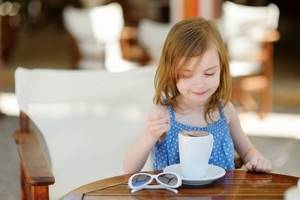
How much and how often can a child drink this “coffee”?
Surrogate “coffee” begins to be given to children from the age of two. The daily consumption rate is no more than 200-250 ml per day. It is recommended to take an invigorating drink in the first half of the day to avoid overstimulation.
As an alternative, children can be given cocoa with milk or weakly concentrated tea.
“Mom, today in kindergarten we were treated to a coffee drink, it’s so delicious” - the words of a contented lisping toddler instantly transport you to childhood. At that time, which smelled deliciously of “cock on a stick”, sugar toffees, condensed milk, and yes - . We may have trouble remembering many things and events, but the smells are good - they are not so easy to erase from memory. We drank a coffee drink, imagining that it was real coffee, and we were those same business adults. We dreamed of growing up quickly, naive. But this was a lyrical digression, the author’s trick to further “immerse” the reader in the topic under consideration. Let's take a closer look at what a coffee drink is and what it is eaten with? What is its composition and does it harm our children? Let's find out!
Let's look at the composition
Don't be alarmed; coffee in children's coffee drinks is only in the name. There is no natural coffee in most formulations; it is usually replaced with the following components:
- Chicory;
- Rose hip;
- Barley;
- Acorns;
- Chestnuts;
As can be seen from the list, the composition is very harmless.
Giving a coffee drink to children over two years of age is allowed, the daily norm is no more than 1 cup per day. If the child is not allergic to its constituent components, “surrogate” coffee (it is also called that) will not only not harm the child, but will also saturate the child’s body with the necessary vitamins and microelements. For example, chicory is able to balance the unstable nervous system of children, rose hips have a general strengthening effect. A coffee drink can normalize the intestinal microflora, remove toxic substances (due to oligosaccharides and pectins in its composition), and improve appetite, which is especially important for those with little appetites. The oats included in the composition contain a large amount of protein, which is simply necessary for a rapidly growing child's body, barley contains B vitamins and magnesium.
Sometimes natural coffee is included in the drink. Parents should not worry about this: firstly, the amount is usually insignificant, and secondly, caffeine has an invigorating and tonic effect on the body. If consumed in moderation, it will not cause any harm to the baby’s body. But you should know that an overdose of a drink that contains natural coffee can lead to leaching of calcium from the body (this is a property of caffeine) and provoke increased excitability. Please note that you should avoid drinking this drink in the evening.
Let's consider the nutritional indicators given in the technological map of the drink. So, KBJU of surrogate coffee per 100 grams:
- Proteins 1.56 g;
- Fat 1.33 g;
- Carbohydrates 7.1 g;
- Calorie content 46.7 kcal.
- The card also shows vitamins (B1, B2, C) and microelements (calcium, iron).
Child's coffee debut. Book recipe
There is a first time for everything in life, and it is very important that the first impression of anything is pleasant. Do you want to give your child coffee, but are you afraid that he won't like it? We advise you to follow Max Fry's recipe and brew a magical drink with rose water. It minimizes bitterness, which can cause disgust in a child, and gives the drink a special taste.
To get rose water, you can simply infuse regular water with a few rose buds plucked from the bush. But this method is suitable if you or your neighbors are breeding roses. If this method doesn't work for you, no problem, you can make rose water from dried rose petals, which are sold in the spice department.
Simply soak the dried petals of three to six buds in clean water for several hours. In extreme cases, you can use rose syrup. Three to four spoons per small cezve is what you need.
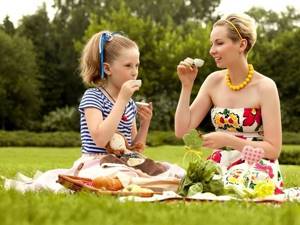
When the rose water is ready, grind the coffee in a coffee grinder, preferably African beans. Then fill the cezve with rose water, add a couple of heaped spoons of freshly ground coffee (in this order, since dry roasting can give the drink additional bitterness) and a pinch of cinnamon (you can also try cardamom and nutmeg, but do not overuse it - the child may not like it). appreciate the taste is too rich).
Cook the drink over low heat until a high head of foam appears, remove it from the heat twice and stir, add a spoonful of cold water to the finished drink so that the grounds settle, give the child a saucer with cane sugar, which he can put in the cup without limitation, and observe the reaction. Most likely, the baby will be satisfied.
Drink to activate strength and mental activity
Coffee is truly a miraculous drink. It stimulates brain activity, improves memory, allows you to absorb more information, feel cheerful and full of energy, increases endurance and reaction speed, activates the gastrointestinal tract (if you or your baby do not have stomach problems) and simply improves mood .
Of course, you need to follow strict rules, because even an adult, excessively strong coffee in large quantities has a detrimental effect. And a student shouldn’t turn drinking coffee into an everyday ritual; it’s better to come up with a special coffee ritual that will take place once or twice a week and can turn into a real holiday.
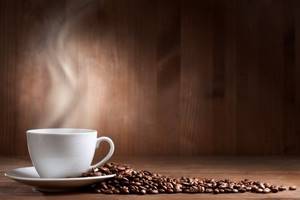
Recipe for “activating” coffee:
We brew two teaspoons of natural coffee in a cezve, at this time we bring two teaspoons of cocoa powder, two tablespoons of brown sugar and 100 grams of milk to a homogeneous consistency.
Pour two-thirds of coffee and one-third of the resulting hot chocolate into a cup, garnish the drink with whipped cream, grated orange zest and chopped walnuts. We drink together with the child, agreeing to share the delicious foam from our cup.
